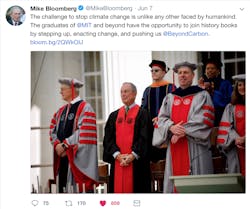Editor's Note: One Small Step, One Giant... Opportunity
Fifty years ago this month, I had just turned 7 and, like most Americans then, my eyes were glued to the fuzzy images being broadcast from Space onto a black-and-white television set in our living room. As a child, I knew something big was happening when astronaut Neil Armstrong became the first human to set foot on the Moon. But I had no idea how truly difficult and dangerous
the achievement was.
Who knew? The engineers did.
Engineers Armstrong and fellow Apollo 11 crewmate Buzz Aldrin** knew. Engineers at NASA’s Mission Control all knew, too. The risk was enormous. The challenge was unprecedented. Others had already died trying. But talent and drive and confidence in the human ability to solve problems ultimately prevailed.
Last month, an electrical engineer named Michael Bloomberg spoke to the graduating class of engineers at Aldrin’s alma mater, the Massachusetts Institute of Technology. Speaking with urgency, the billionaire challenged engineering students everywhere to join him in on a new massive mission:
Today, I am committing $500 million to launch a new national climate initiative, Beyond Carbon. Our goal is to move the U.S. toward a 100% clean energy economy as expeditiously as possible, beginning right now. We intend to succeed not by sacrificing things we need but by investing in things we want: more good jobs, cleaner air and water, cheaper power, more transportation options, and less congested roads.
The independent former NYC mayor says he no longer has political ambitions, largely because he believes the problems we face now are too immediate to wait on political change. At M.I.T., he concluded his remarks, telling the new engineers, “We will need your minds and your creativity to achieve a clean energy future. But that is not all. We need your voices, we need your votes, and we need you to help lead us where Washington won’t. It may be a moonshot — but it’s the only shot we’ve got.”
Also last month in nearby Andover MA, I heard compelling echoes of that call to action at Schneider Electric’s North American R&D Center. From digital energy and smart buildings to sustainability and operational efficiency, the French-owned player in innovation and connectivity is determined to be a leader in multiple rapidly changing markets.
Toward that end, Harvard University Asst. Prof. Joseph Allen presented the latest results of his ongoing COGfx Study: The Impact of Green Buildings on Cognitive Function, sponsored in part by United Technologies. Now in phase three, the multi-year research aims to study 100 buildings all over the world to determine the structural and environmental factors that influence health, well-being, and productivity. “We believe this data will help building managers, designers, architects, and developers create healthy work environments,” said Allen. “Remember, on average, 90% of our lives are spent indoors.”
Started in 2014, #THECOGFXSTUDY has collected an immense amount of data that we will undoubtedly write about more in the future. But for now, I will just note one eye-popping statistic: the buildings studied report 25-45% energy wasted by inefficient HVAC systems.
That should spell ‘OPPORTUNITY’ in all caps for this industry for decades to come. As inefficient cities struggle to grow exponentially all over the world, you need not shy away from the immense challenges before you. After all, you are engineers.
**BONUS TRIVIA: Do you know what Buzz Aldrin's mother's maiden name was?
ANSWER: Incredibly, it was 'Moon'. She was born 'Marion Moon'.
About the Author
Rob McManamy
Editor in Chief
An industry reporter and editor since 1987, McManamy joined HPAC Engineering in September 2017, after three years with BuiltWorlds.com, a Chicago-based media startup focused on tech innovation in the built environment. He has been covering design and construction issues for more than 30 years, having started at Engineering News-Record (ENR) in New York, before becoming its Midwest Bureau Chief in 1990. In 1998, McManamy was named Editor-in-Chief of Design-Build magazine, where he served for four years. He subsequently worked as an editor and freelance writer for Building Design + Construction and Public Works magazines.
A native of Bronx, NY, he is a graduate of both the University of Virginia, and The John Marshall Law School in Chicago.
Contact him at [email protected].

